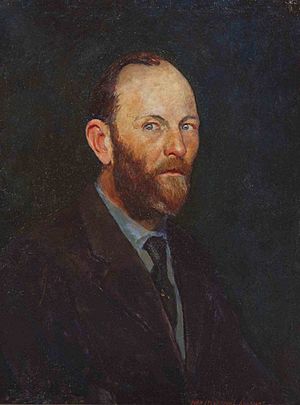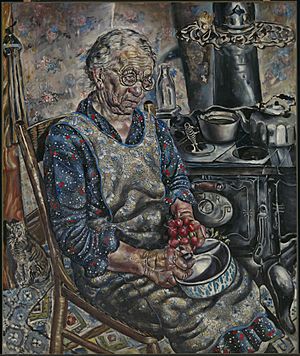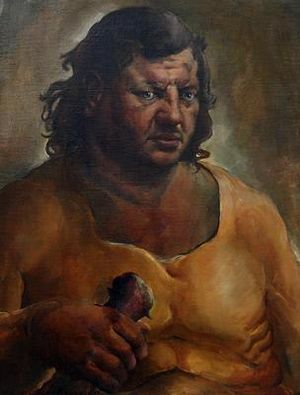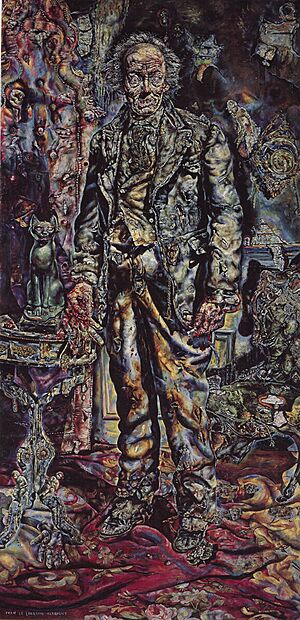Ivan Albright facts for kids
Quick facts for kids
Ivan Albright
|
|
|---|---|
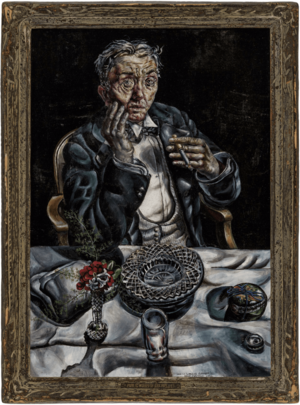
Self-Portrait, 1934, oil on canvas. Collection of New Trier High School District 203
|
|
| Born |
Ivan Le Lorraine Albright
February 20, 1897 North Harvey, Illinois, U.S.
|
| Died | November 18, 1983 (aged 86) Woodstock, Vermont, U.S.
|
| Education | Art Institute of Chicago The National Academy of Design Pennsylvania Academy of the Fine Arts |
| Known for | Painting, Drawing, Poetry |
| Style | Magic Realism |
| Spouse(s) | Josephine Medill Patterson |
Ivan Le Lorraine Albright (born February 20, 1897 – died November 18, 1983) was an American painter. He was also a sculptor and print-maker. He is best known for his self-portraits, studies of people, and still life paintings. His unique style and often dark subjects led people to call him a "Magic Realist." Some even called him the "master of the macabre," meaning he focused on strange or gloomy things.
Albright came from a family of artists. He became well-known in the 1930s as a unique American Realist painter. His art often showed how fragile the human body and life can be. Paintings like The Lineman (1928) and That Which I Should Have Done I Did Not Do (The Door) (1931) surprised many people. He paid extreme attention to tiny details and textures. Because of this, he often spent many years or even decades on just one painting.
You can find Albright's paintings in museums all over the United States. The largest collection of his works is at the Art Institute of Chicago.
About Ivan Albright's Life
Ivan Albright's family, the Albrights (originally Albrecht), had a history of art and craftsmanship. His great-great-grandfather was a master gunsmith in Germany. Ivan's father, Adam Emory Albright, was an Impressionist painter. He was known for his landscapes and paintings of children.
Early Life and Learning
Ivan and his identical twin brother, Malvin Marr Albright, were born in 1897. They grew up near Chicago, Illinois. Their father often used them as models in his paintings until they were eleven. He also started teaching them to draw when they were eight. This included formal drawing lessons and trips to the Art Institute of Chicago. Through their father, they met many famous American artists. These early experiences helped shape their future careers as painters.
Ivan's early education was not very steady. His family moved often because of his father's work. In 1910, they settled in Hubbard Woods. There, Ivan and Malvin could attend New Trier High School. Ivan went to Northwestern University in 1915 but did not finish. Later, in 1916, he studied at the University of Illinois at Urbana–Champaign. He thought about becoming an architect or a chemical engineer.
It wasn't until 1918 that Ivan seriously considered being an artist. This happened after a family painting trip to Venezuela. That same year, he showed his first painting, The Oaks in Winter, at the Art Institute of Chicago.
World War I changed his plans. Both Ivan and his brother joined the U.S. Army Medical Corps. They were stationed in France from 1918 to 1919. During this time, Albright created many medical drawings of surgeries and wounds. These drawings showed his growing interest in the human body and its fragility. Many art experts believe these drawings sparked his focus on the human condition.
After working briefly in architecture and advertising, Ivan and Malvin joined the Art Institute of Chicago in 1920. Ivan studied painting and Malvin studied sculpture. They both received traditional art training. Ivan graduated in 1923. He then continued his studies at the Pennsylvania Academy of the Fine Arts and the National Academy of Design. By 1925, he and Malvin opened a studio in Philadelphia, starting their professional art careers.
Becoming a Professional Artist
Between 1925 and 1926, Albright's unique "baroque" style began to appear. This style showed the human condition in a very direct way, which some people found shocking. In 1927, he and Malvin returned to Illinois. Their father had turned an old church into the Albright Gallery. Malvin started using the name Zsissly so people wouldn't confuse his work with Ivan's.
During this time, Ivan's art began to cause debate. In 1928, his painting The Lineman was on the cover of a magazine. The magazine's readers thought the painting was too sad. However, art critics loved it. Later, his painting Woman (1928) was shown at a museum. Some people protested and had it removed, but then another group protested its removal!
By 1931, Albright's career was taking off, even with the Great Depression. He showed fourteen paintings at the Art Institute of Chicago. He also started his huge painting, That Which I Should Have Done I Did Not Do (The Door) (1931), which took him ten years to finish. Albright said the Depression didn't affect him much because people rarely bought his paintings anyway. His father's success helped him live comfortably.
Like many artists during that time, Albright worked on the Public Works of Art Project. He painted The Farmer's Kitchen (1933–34) and a Self-Portrait (1934) for this project. The Farmer's Kitchen showed a hardworking American woman. But Albright also showed her tiredness and aging, which was his way of looking at life more realistically than other artists of the time.
The 1940s brought many changes for Albright. His mother passed away in 1939. He, Malvin, and Adam spent several summers painting in Maine. In 1941, he finished The Door. He then started Poor Room – There Is No Time, No End, No Today, No Yesterday, No Tomorrow, Only the Forever and Forever and Forever Without End (The Window). He worked on The Window for 21 years!
His work on The Window was paused when he and Malvin were asked to paint for the movie The Picture of Dorian Gray. Albright wanted to work under the same bright lights as the movie set. This led him to use bolder colors in his paintings. In 1946, Ivan married Josephine Medill Patterson Reeve. He adopted her children. They later had a son, Adam, in 1947, and a daughter, Blandina, in 1949.
Later Years and Art
In his later career, Albright focused a lot on portraits and self-portraits. He finished The Window in 1962. Then he painted a portrait of his father-in-law, Captain Joseph Medill Patterson (1962–64). In 1963, he painted the Aspen Self Portrait, showing himself at age sixty-six.
The 1950s and 1960s saw Albright travel more. He painted many works with Western themes. This was partly because his wife's family owned a ranch in Wyoming. He painted works like Roaring Fork, Wyoming (1948) and The Rustlers (1959). He also inherited a plantation in Georgia, which made him interested in painting swamps.
In 1963, Albright and his family moved to Woodstock, Vermont. This was partly because his Chicago studio was torn down for a shopping mall. Also, Albright felt out of place in the Chicago art scene. Modern art like Pop Art and Minimalism were popular, which was very different from his detailed style. In Vermont, he completed what many consider his last major work, If Life Were Life – There Would Be No Death (The Vermonter) (1966–77).
When Albright was 75, his eyesight began to get worse due to cataracts. He had surgery in 1977, which helped him see better. That year, he gave many of his artworks to the Art Institute of Chicago. His health declined later. His last paintings were a series of self-portraits done between 1981 and 1983. He made over twenty-four of these. He finished the last one just days before he passed away on November 18, 1983.
Albright's Artistic Style
Albright developed his unique painting technique in the 1930s. He would make many detailed drawings first. He also created his own special colors and used hundreds of tiny brushes. This slow and careful method allowed him to show every tiny detail of objects and people, especially how they aged or decayed. It also let him show different viewpoints and how objects related to each other.
His mix of extreme realism with strong, sometimes unsettling colors led art critics to call his work "Magic Realism." This style often shows everyday things in a strange or dreamlike way.
In the late 1950s and 1960s, he also used metalpoint for his drawings. This is a technique where you draw with a metal stylus on specially prepared paper.
Albright's paintings often explored themes like:
- Death and life
- The difference between spiritual and physical things
- The effects of time passing
His painting titles were also very long and complex. He would only name a painting after it was finished. For example, a painting of a window is called Poor Room – There is No Time, No End, No Today, No Yesterday, No Tomorrow, Only the Forever, and Forever and Forever Without End (The Window). People usually just call it The Window.
Famous Works
Into the World There Came a Soul Called Ida (1929–30)
This painting shows a woman named Ida. It suggests that the human body is weak and that we are stuck inside our physical forms. There seems to be a struggle between the soul and the body. Ida sits in a messy, old room, looking sadly into a mirror. Some people think she is sad about getting older or losing her beauty. This painting is like many of Albright's works because it shows a decaying figure and has deeper, often dark, meanings.
That Which I Should Have Done I Did Not Do (The Door) (1931–1941)
This is one of Albright's most famous paintings. It took him ten years to complete! In 1941, it won top awards at three big art shows in New York City, Chicago, and Philadelphia. The Metropolitan Museum of Art in New York wanted to buy it. But Albright set the price very high, so he kept the painting instead. You can see this painting today at the Art Institute of Chicago.
The Picture of Dorian Gray (1943)
In 1943, Albright was asked to paint the main picture for the movie The Picture of Dorian Gray. The story is about a man whose portrait ages and becomes ugly instead of him. Albright's style, which showed decay in a very real way, was perfect for painting the corrupted Dorian. His brother was supposed to paint the "good" version of Dorian. However, another artist's painting was used for the uncorrupted version. When the painting needed to show Dorian's decay, Albright added those changes. His painting of the corrupted Dorian Gray is now at the Art Institute of Chicago.
Albright's Impact and Legacy
Albright's paintings are in many important museums across the United States. These include the Museum of Modern Art, the Metropolitan Museum of Art, and the National Gallery of Art. The largest and most important collection of his art is at the Art Institute of Chicago. This shows how special his connection was with that museum. The Institute has 137 of his paintings, drawings, and sculptures. They also work to share his art through books and exhibitions. Major shows of his work were held in 1964 and 1997.
Albright was smart about making sure his art was in top museums. He often allowed museums to trade his works for even better examples. For instance, in 1947, the Art Institute traded one painting for Into the World There Came a Soul Called Ida. In 1956, they traded Ida and two other paintings for his masterpiece, The Door.
In 1977, Albright gave 75 of his personal artworks to the museum. After he passed away, his wife, Josephine, donated 20 more self-portraits. She also gave a collection of his personal papers, sketches, and notebooks. These are now kept at the Art Institute of Chicago, helping people learn more about his life and work.
See also
 In Spanish: Ivan Albright para niños
In Spanish: Ivan Albright para niños
- Gertrude Abercrombie
- Aaron Bohrod
- Paul Cadmus
- Jared French
- William S. Schwartz
- George Tooker
- John Wilde



